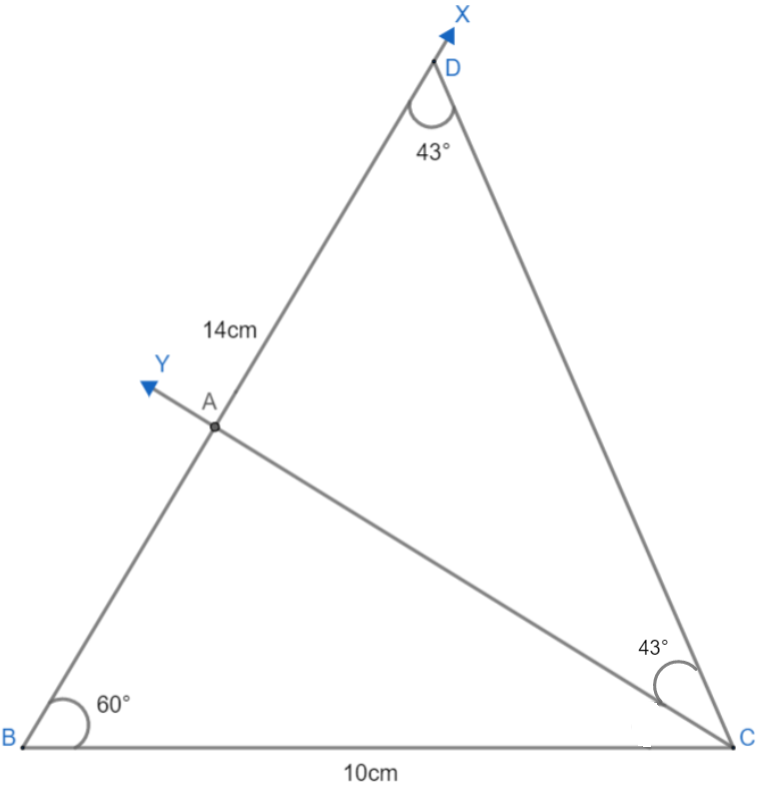
To construct a triangle ABC in which BC = 10cm and $\angle B={{60}^{\circ }}$ and AB+AC = 14cm, then the length of BD used for construction is
\[\begin{align}
& A.7cm \\
& B.14cm \\
& C.20cm \\
& D.10cm \\
\end{align}\]
Answer
558.6k+ views
Hint: In this question, we need to find the length of BD which is used for constructing triangle ABC. In triangle ABC, we have BC = 10cm, $\angle B={{60}^{\circ }}$ and AB+AC = 14cm. We will construct triangle ABC using given measures and then find the length of BD using isosceles triangle property. According to the isosceles triangle property, the angles corresponding to equal sides are also equal.
Complete step-by-step solution
Let us construct triangle ABC in which BC = 10cm, $\angle B={{60}^{\circ }}$ and AB+AC = 14cm. We will use following steps of construction:
(i) Draw line segment BC = 10cm. At B, let us draw an angle, say $\angle XBC$ which is equal to ${{60}^{\circ }}$ using a protractor.

(ii) Now, cut the ray BX at the length of AB+AC = 14cm at point D (open compass at 14cm and cut the ray and mark the point as D). And then join DC.

(iii) Now, measure $\angle BDC$ and make the same angle at C naming DCY. Ray CY cuts the line BD at point A.

Hence, $\Delta ABC$ is the required triangle with BC = 10cm, AB+AC = 14cm and $\angle B={{60}^{\circ }}$.
Now, we need to find the length BD. Since BD was already drawn as 14cm so BD = 14cm.
But let us prove BD as 14cm.
From $\Delta ACD$ we can see that, $\angle ADC=\angle DCA$.
Hence, $\Delta ACD$ is an isosceles triangle.
So, AD = AC by the reverse of isosceles triangle property.
We know that, AB+AC = 14cm. Putting AD = AC we get: AB+AD = 14cm.
From the diagram, we can see that AB+AD = BD.
Hence, BD = 14cm.
Hence, option B is the correct answer.
Note: Students should take care while measuring the angle $\angle BDC$. When drawing angle $\angle DCY$ make sure to take base as CD and then measure the angle using a protractor. For making an angle of ${{60}^{\circ }}$ students can use a protractor or compass. Make sure pencils are sharp and the compass is tight.
Complete step-by-step solution
Let us construct triangle ABC in which BC = 10cm, $\angle B={{60}^{\circ }}$ and AB+AC = 14cm. We will use following steps of construction:
(i) Draw line segment BC = 10cm. At B, let us draw an angle, say $\angle XBC$ which is equal to ${{60}^{\circ }}$ using a protractor.

(ii) Now, cut the ray BX at the length of AB+AC = 14cm at point D (open compass at 14cm and cut the ray and mark the point as D). And then join DC.

(iii) Now, measure $\angle BDC$ and make the same angle at C naming DCY. Ray CY cuts the line BD at point A.

Hence, $\Delta ABC$ is the required triangle with BC = 10cm, AB+AC = 14cm and $\angle B={{60}^{\circ }}$.
Now, we need to find the length BD. Since BD was already drawn as 14cm so BD = 14cm.
But let us prove BD as 14cm.
From $\Delta ACD$ we can see that, $\angle ADC=\angle DCA$.
Hence, $\Delta ACD$ is an isosceles triangle.
So, AD = AC by the reverse of isosceles triangle property.
We know that, AB+AC = 14cm. Putting AD = AC we get: AB+AD = 14cm.
From the diagram, we can see that AB+AD = BD.
Hence, BD = 14cm.
Hence, option B is the correct answer.
Note: Students should take care while measuring the angle $\angle BDC$. When drawing angle $\angle DCY$ make sure to take base as CD and then measure the angle using a protractor. For making an angle of ${{60}^{\circ }}$ students can use a protractor or compass. Make sure pencils are sharp and the compass is tight.
Recently Updated Pages
Master Class 7 Social Science: Engaging Questions & Answers for Success

Master Class 7 Science: Engaging Questions & Answers for Success

Class 7 Question and Answer - Your Ultimate Solutions Guide

Master Class 7 English: Engaging Questions & Answers for Success

Master Class 7 Maths: Engaging Questions & Answers for Success

Master Class 6 English: Engaging Questions & Answers for Success

Trending doubts
Full Form of IASDMIPSIFSIRSPOLICE class 7 social science CBSE

Convert 200 Million dollars in rupees class 7 maths CBSE

What are the controls affecting the climate of Ind class 7 social science CBSE

Write a letter to the editor of the national daily class 7 english CBSE

List of coprime numbers from 1 to 100 class 7 maths CBSE

Fill in the blanks with appropriate modals a Drivers class 7 english CBSE





